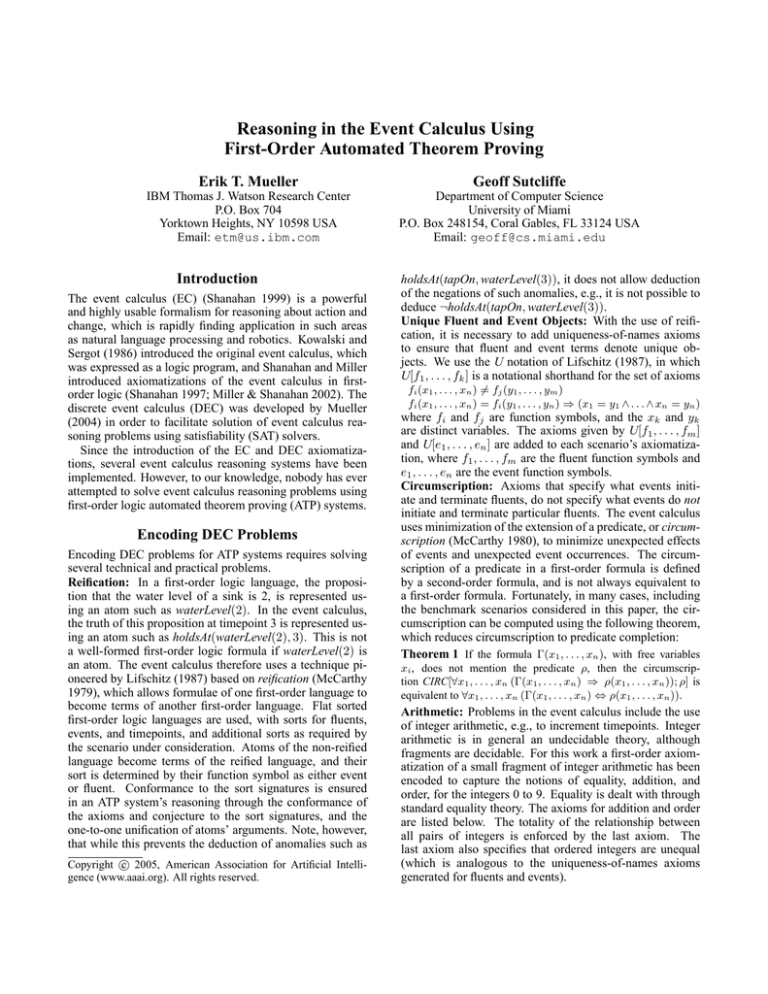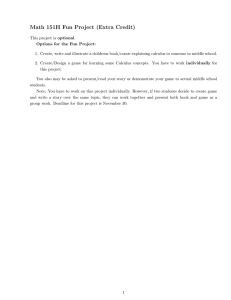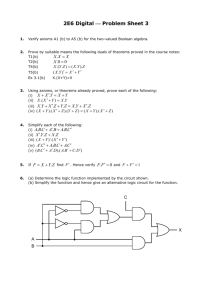
Reasoning in the Event Calculus Using
First-Order Automated Theorem Proving
Erik T. Mueller
Geoff Sutcliffe
IBM Thomas J. Watson Research Center
P.O. Box 704
Yorktown Heights, NY 10598 USA
Email: etm@us.ibm.com
Department of Computer Science
University of Miami
P.O. Box 248154, Coral Gables, FL 33124 USA
Email: geoff@cs.miami.edu
Introduction
The event calculus (EC) (Shanahan 1999) is a powerful
and highly usable formalism for reasoning about action and
change, which is rapidly finding application in such areas
as natural language processing and robotics. Kowalski and
Sergot (1986) introduced the original event calculus, which
was expressed as a logic program, and Shanahan and Miller
introduced axiomatizations of the event calculus in firstorder logic (Shanahan 1997; Miller & Shanahan 2002). The
discrete event calculus (DEC) was developed by Mueller
(2004) in order to facilitate solution of event calculus reasoning problems using satisfiability (SAT) solvers.
Since the introduction of the EC and DEC axiomatizations, several event calculus reasoning systems have been
implemented. However, to our knowledge, nobody has ever
attempted to solve event calculus reasoning problems using
first-order logic automated theorem proving (ATP) systems.
Encoding DEC Problems
Encoding DEC problems for ATP systems requires solving
several technical and practical problems.
Reification: In a first-order logic language, the proposition that the water level of a sink is 2, is represented using an atom such as waterLevel(2). In the event calculus,
the truth of this proposition at timepoint 3 is represented using an atom such as holdsAt(waterLevel(2), 3). This is not
a well-formed first-order logic formula if waterLevel(2) is
an atom. The event calculus therefore uses a technique pioneered by Lifschitz (1987) based on reification (McCarthy
1979), which allows formulae of one first-order language to
become terms of another first-order language. Flat sorted
first-order logic languages are used, with sorts for fluents,
events, and timepoints, and additional sorts as required by
the scenario under consideration. Atoms of the non-reified
language become terms of the reified language, and their
sort is determined by their function symbol as either event
or fluent. Conformance to the sort signatures is ensured
in an ATP system’s reasoning through the conformance of
the axioms and conjecture to the sort signatures, and the
one-to-one unification of atoms’ arguments. Note, however,
that while this prevents the deduction of anomalies such as
c 2005, American Association for Artificial IntelliCopyright gence (www.aaai.org). All rights reserved.
holdsAt(tapOn, waterLevel(3)), it does not allow deduction
of the negations of such anomalies, e.g., it is not possible to
deduce ¬holdsAt(tapOn, waterLevel(3)).
Unique Fluent and Event Objects: With the use of reification, it is necessary to add uniqueness-of-names axioms
to ensure that fluent and event terms denote unique objects. We use the U notation of Lifschitz (1987), in which
U[f1 , . . . , fk ] is a notational shorthand for the set of axioms
fi (x1 , . . . , xn ) 6= fj (y1 , . . . , ym )
fi (x1 , . . . , xn ) = fi (y1 , . . . , yn ) ⇒ (x1 = y1 ∧ . . . ∧ xn = yn )
where fi and fj are function symbols, and the xk and yk
are distinct variables. The axioms given by U[f1 , . . . , fm ]
and U[e1 , . . . , en ] are added to each scenario’s axiomatization, where f1 , . . . , fm are the fluent function symbols and
e1 , . . . , en are the event function symbols.
Circumscription: Axioms that specify what events initiate and terminate fluents, do not specify what events do not
initiate and terminate particular fluents. The event calculus
uses minimization of the extension of a predicate, or circumscription (McCarthy 1980), to minimize unexpected effects
of events and unexpected event occurrences. The circumscription of a predicate in a first-order formula is defined
by a second-order formula, and is not always equivalent to
a first-order formula. Fortunately, in many cases, including
the benchmark scenarios considered in this paper, the circumscription can be computed using the following theorem,
which reduces circumscription to predicate completion:
Theorem 1 If the formula Γ(x1 , . . . , xn ), with free variables
xi , does not mention the predicate ρ, then the circumscription CIRC[∀x1 , . . . , xn (Γ(x1 , . . . , xn ) ⇒ ρ(x1 , . . . , xn )); ρ] is
equivalent to ∀x1 , . . . , xn (Γ(x1 , . . . , xn ) ⇔ ρ(x1 , . . . , xn )).
Arithmetic: Problems in the event calculus include the use
of integer arithmetic, e.g., to increment timepoints. Integer
arithmetic is in general an undecidable theory, although
fragments are decidable. For this work a first-order axiomatization of a small fragment of integer arithmetic has been
encoded to capture the notions of equality, addition, and
order, for the integers 0 to 9. Equality is dealt with through
standard equality theory. The axioms for addition and order
are listed below. The totality of the relationship between
all pairs of integers is enforced by the last axiom. The
last axiom also specifies that ordered integers are unequal
(which is analogous to the uniqueness-of-names axioms
generated for fluents and events).
0 + 0 = 0, 0 + 1 = 1, . . . , 8 + 1 = 9
∀X, Y X + Y = Y + X
∀X, Y (X ≤ Y ⇔ (X < Y ∨ X = Y ))
∀X (X < 1 ⇔ X ≤ 0), . . . , ∀X (X < 9 ⇔ X ≤ 8)
¬∃X X < 0
∀X, Y (X < Y ⇔ (¬(Y < X) ∧ Y 6= X))
Figure 1: Lemmas for the Kitchen Sink Theorems
axioms
104s
holdsAt(waterLevel(3),3)
9s
Testing
The above encoding techniques have been tested on two
benchmark scenarios. In each case the axioms for the particular scenario are preprocessed by adding the necessary
uniqueness-of-names axioms and performing the necessary
predicate completions. The preprocessed axioms are then
added to the DEC and integer arithmetic axioms. A conjecture formula is then added to produce a first-order ATP
problem. The ATP problems were submitted to the stateof-the-art ATP system Vampire 7.0 (Riazanov & Voronkov
2002), with a 300s time limit.
The Supermarket Trolley Scenario: The supermarket trolley scenario is used to test the handling of concurrent events
with cumulative and canceling effects. The scenario is as
follows: If a trolley is pushed, it moves forward. If it
is pulled, it moves backward. If the trolley is simultaneously pulled and pushed, it spins around. The axiomatization of this problem is that of Shanahan (1997), reformulated using the technique of Miller and Shanahan (2002),
which involves adding happens preconditions to initiates
and terminates axioms. Various theorems, e.g., that when
the trolley is both pushed and pulled at time 2 then it is spinning at time 3, were proved by Vampire in less than 1 second
per proof.
The Kitchen Sink Scenario: In the kitchen sink scenario
(Shanahan 1990) a stopper is put into the drain of a kitchen
sink and the water is turned on. The task is to perform
temporal projection, a form of deduction, in order to infer
that the water level will rise, the water level will reach the
rim of the sink, and then the water will overflow and start
spilling. Various theorems that describe the state of the system at specified times were proved directly from the axioms
within the 300s time limit, e.g., at time 3 the the water level
is 3, and at time 3 the sink is filling. For more complex theorems, e.g., the water level at time 4 is still 3 (because the
sink started overflowing at time 3), Vampire was unable to
prove them directly from the axioms within the 300s time
limit. For each of these it was necessary to specify which of
the previously proved theorems should be used as lemmas,
so that the harder theorem could be proved from the axioms
and lemmas. Figure 1 shows the lemma structure used, leading to proofs of the most difficult theorems. Each link shows
the CPU time taken to prove the lemma or theorem. When
proving the theorems, the axioms as well as the indicated
lemmas are used.
Conclusions
This paper shows, with techniques and examples, how DEC
reasoning problems can be encoded in first-order logic. Solutions to the technical issues regarding the translation of
174s
holdsAt(filling,4)
83s
holdsAt(filling,3)
110s
1s
happens(overflow,3)
holdsAt(waterLevel(3),4)
holdsAt(spilling,4)
DEC problems into pure first-order logic have been found,
and the resulting ATP problems have been successfully tackled with a state-of-the-art ATP system. The result is a new
and practical technology for solving DEC problems. Since
the original submission of this paper, a complete axiomatization of equality, addition, and ordering for integers has been
developed, and this will replace the fragment described. We
plan to add the problems to the TPTP problem library (Sutcliffe & Suttner 1998) in a new domain focusing on commonsense reasoning. In the future it is planned to extend
this work to the standard event calculus, in which time is not
forced to be discrete.
References
Kowalski, R. A., and Sergot, M. J. 1986. A logic-based
calculus of events. New Generation Computing 4(1):67–
95.
Lifschitz, V. 1987. Formal theories of action. In The Frame
Problem in Artificial Intelligence, 35–57.
McCarthy, J. 1979. First order theories of individual concepts and propositions. In Machine Intelligence 9. 129–
148.
McCarthy, J. 1980. Circumscription—a form of nonmonotonic reasoning. Artificial Intelligence 13:27–39.
Miller, R., and Shanahan, M. 2002. Some alternative formulations of the event calculus. In Computational Logic:
Logic Programming and Beyond. 452–490.
Mueller, E. T. 2004. Event calculus reasoning through satisfiability. Journal of Logic and Computation 14(5):703–
730.
Riazanov, A., and Voronkov, A. 2002. The design and implementation of Vampire. AI Communications 15(2-3):91–
110.
Shanahan, M. 1990. Representing continuous change in
the event calculus. In Proc. of ECAI 1990, 598–603.
Shanahan, M. 1997. Solving the Frame Problem. MIT
Press.
Shanahan, M. 1999. The event calculus explained. In
Artificial Intelligence Today. Springer-Verlag. 409–430.
Sutcliffe, G., and Suttner, C. 1998. The TPTP Problem
Library: CNF release v1.2.1. Journal of Automated Reasoning 21(2):177–203.




